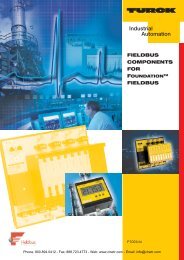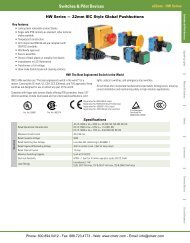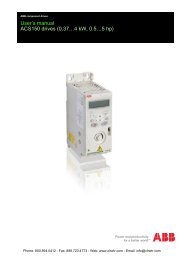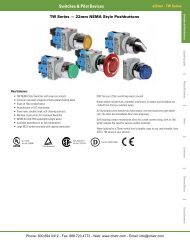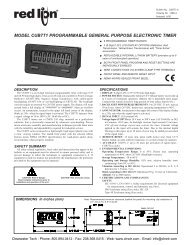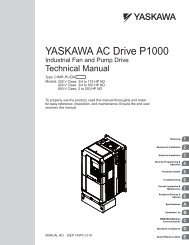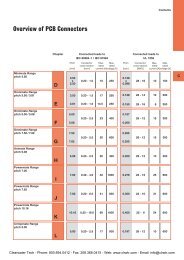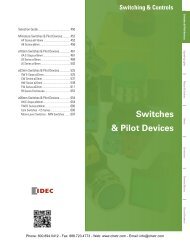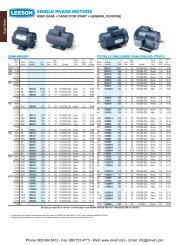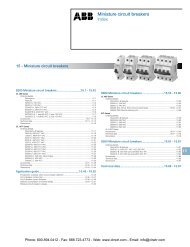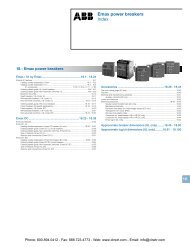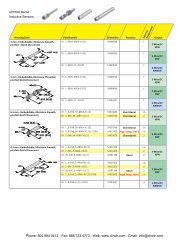IDEC / Datasensor Sensors - Clearwater Technologies, Inc.
IDEC / Datasensor Sensors - Clearwater Technologies, Inc.
IDEC / Datasensor Sensors - Clearwater Technologies, Inc.
Create successful ePaper yourself
Turn your PDF publications into a flip-book with our unique Google optimized e-Paper software.
General Information<br />
<strong>Sensors</strong><br />
<strong>Sensors</strong><br />
Power Supplies<br />
Automation Software<br />
Operator Interfaces<br />
PLCs<br />
applications. Plastic optic fibers have a standard 2.2mm external diameter and<br />
generally have a cylindrical threaded metal head on the end used for mechanical<br />
mounting. These fibers are usually 1 and 2 meters in length as reductions in performance<br />
become significant with lengths over 5 meters. Plastic optic fi bers can<br />
be shortened using a special fi ber-cutting tool, but, it can only be used a limited<br />
number of times. Cutting the fi ber with a non-sharp or non-perpendicular blade<br />
will reduce operating distance. High temperature, extra-fl exible or high effi ciency<br />
plastic optic fibers are also available.<br />
Through-beam fi bers<br />
Proximity fi bers<br />
Laser <strong>Sensors</strong><br />
A LASER (Light Amplifi cation by Stimulated Emission of Radiation) is<br />
an electronic device, such as a diode, that converts an energy source<br />
into a very thin and concentrated light beam, suitable for detecting<br />
very small objects or to reach very long operating distances. With reference to<br />
the safety of laser radiation (according to the EN60825-1 European standard)<br />
class 1 requires that the laser device is safe under<br />
reasonable operating conditions and is not dangerous<br />
for people in any situation; while class 2 states that<br />
the eye cannot be protected just by looking away or<br />
blinking, thus precautions must be adopted to avoid<br />
staring into the beam.<br />
IMPORTANT: Always consider safety when installing a laser sensor of any<br />
kind. Make sure that the laser beam cannot inadvertently shine into the eyes of<br />
people passing by or working in the vicinity. See safety information on page 232.<br />
Mounting<br />
Mounting brackets and hardware are included with sensors, where applicable.<br />
Use the hardware for mounting, along with washers and spring washers or lock<br />
nuts. Do not overtighten hardware. Overtightening causes damage to the housing<br />
and will adversely affect the waterproof characteristics of the sensor.<br />
Best results can be obtained when the sensor is mounted so that the object<br />
sensed is in the center of the beam, rather than when the object is located near<br />
the edges of the sensing window. In addition, the most reliable sensing occurs<br />
when the majority of the objects being sensed are well within the sensing range,<br />
rather than at the extreme near and far limits.<br />
When extending sensor cables and wires, make sure to use cables equal or<br />
superior to that recommended in the individual specifi cations sections.<br />
When wiring terminals, be sure to prevent contact between adjoining terminals.<br />
When using ring or fork lug terminals, use the insulated sleeve style only. Each<br />
sensor terminal can accept only one ring or fork lug terminal.<br />
Power Supply<br />
Noise resistance characteristics are improved when a sensor is grounded to the<br />
0V power terminal. If the 0V power terminal is not at ground potential, use a<br />
ceramic 0.01μF capacitor which can withstand 250V AC minimum.<br />
Part Number Output Ratings<br />
PS5R-A12 12V DC, 0.62A<br />
PS5R-A24 24V DC, 0.32A<br />
When using a switching power supply, be sure to ground<br />
the FG terminal to eliminate high-frequency noise. The<br />
power supply should include an insulating transformer, not<br />
an autotransformer.<br />
The compact PS5R-A power supply is the perfect companion<br />
item for most <strong>IDEC</strong> sensors. This power supply is only<br />
1.77” (45mm) wide, 3.15” (80mm) tall, and 2.76” (70mm)<br />
deep. Call an <strong>IDEC</strong> representative for more details.<br />
Miscellaneous<br />
Strong magnetic fi elds may detract from the accuracy of the sensing measurements.<br />
Avoid mounting a sensor directly to machinery, since the housing is connected<br />
to the electronic circuit ground of the sensor. If it is necessary to mount a<br />
sensor on machinery, use the insulating plate and sleeve provided.<br />
Communication & Networking<br />
Wiring<br />
Avoid running high-voltages or power lines in the same conduit with sensor<br />
signal lines. This prevents inaccurate results or damage from induced noise. Use<br />
a separate conduit when the infl uence of power lines or electromagnetic equipment<br />
may occur, particularly when the distance of the wiring is extended.<br />
IMPORTANT: Connect the sensor cables and wires as noted in the individual<br />
Wiring sections. Failure to connect as shown in wiring diagrams will result in<br />
damage to the internal circuit.<br />
236 <strong>Clearwater</strong> Tech - Phone: 800.894.0412 - Fax: 208.368.0415 www.idec.com- Web: www.clrwtr.com - Email: info@clrwtr.com




